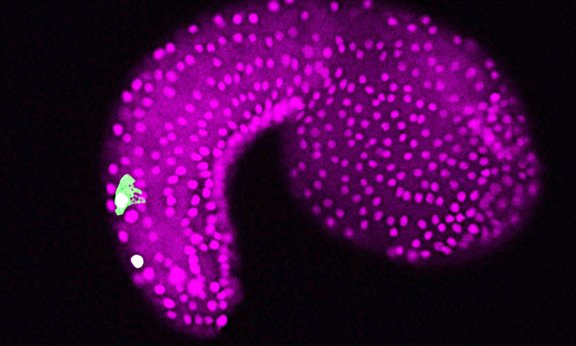Having a head is quite an advantage. Although this may sound banal, it had to be tested by evolution in a long process: As animal life developed, it was invertebrates who initially dominated the oceans. These already possessed head structures, but it was the development of a novel, improved head that led to the success of vertebrates. This 'new head' allowed a wide spatial distribution and multiplication of sensory cells and thus a much better perception of the environment. This was also essential for the development of a predatory lifestyle.
When external stimuli are transmitted to the vertebrate brain, Cranial Sensory Ganglia play an important role. These can be thought of as nerve nodes distributed throughout the head that receive information from the sensory organs. Until now, scientists did not know how exactly these ganglia were formed. A study which was published in "Nature" now found answers.
Prototype of the vertebrates
The research group of Ute Rothbächer from the Institute of Zoology at the University of Innsbruck was decisively involved in the last phase of the project, an international collaboration of several institutions, conceived by the University of Oxford. Their findings show that the Cranial Sensory Ganglia of vertebrates emerge from a genetic program that is also found in their closest living relatives, the tunicates. In tunicate larvae, certain sensory neurons, called Bipolar Tail Neurons, are located in the tail region. These process external stimuli, but are also responsible for the animal's movement. In both animal subphyla, the respective structures are formed by the gene Hmx.
"Tunicates are like an evolutionary prototype for vertebrates," Rothbächer explains. "There is a large anatomical gap between the adults of these subphyla, as they are adapted to ecological niches. This complicates research on their evolution. Common structures and mechanisms can only be identified at the embryonic stage - our common ancestor was probably very similar to a tunicate larva."
The study's model organisms were the lamprey, a primitive fish that resembles an eel and is often referred to as a 'living fossil,' and the tunicate Ciona intestinalis, which is surrounded by a yellowish, tubular mantle that protects the animal and filters food.
The conserved gene
Alessandro Pennati, a doctoral student in Rothbächer's research group, provided decisive data on the function of the gene Hmx in Ciona. He applied the gene technology CRISPR-Cas9 to selectively knock out genetic sequences, while the method of transient transgenesis was used to over-express genes.
The researchers found that Hmx controls the development of Bipolar Tail Neurons in tunicates, whereas in vertebrates, it does so for Cranial Sensory Ganglia. Surprisingly, lamprey Hmx gene segments inserted into Ciona DNA were similarly active as Ciona's own Hmx.
"Hmx has been shown to be a central gene that has been conserved across evolution. It has retained its original function and structure and was probably found in this form in the common ancestor of vertebrates and tunicates," Pennati explains. Cranial Sensory Ganglia and Bipolar Tail Neurons thus have the same evolutionary origin, Hmx was probably crucially involved in the formation of highly specialized head sensory organs in vertebrates.

